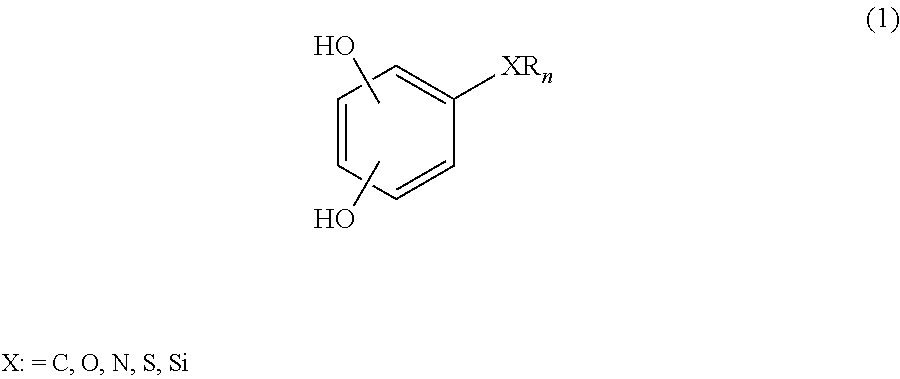Low-viscosity phenolic diglycidyl ethers for epoxy coating applications
a diglycidyl ether, low viscosity technology, applied in the direction of liquid surface applicators, coatings, carbon preparation/purification, etc., can solve the problems of poor applicability, vocs and/or deterioration of the properties of the final coating, and the impracticality of use of heated plural component application equipment,
- Summary
- Abstract
- Description
- Claims
- Application Information
AI Technical Summary
Benefits of technology
Problems solved by technology
Method used
Image
Examples
example 2
2,2′-(((5-pentyl-1,3-phenylene)bis(oxy))bis(methylene)) bis(oxirane)
[0053]
[0054]A 500 mL 3-necked round bottom flask equipped with a condenser, addition funnel and septum under nitrogen was charged in order with: 1,3-dihydroxy-5-pentylbenzene (6.0 g, 33.3 mmol), Dowanol PM solvent (35.4 mL, 359.5 mmol), epichlorohydrin (106.5 mL, 1.33 mol), and water (1.9 mL, 106.5 mmol). The colorless solution was then heated to 52° C. before addition of sodium hydroxide (20% solution, 12.0 g, 59.9 mmol). The solution was then stirred at 52° C. for an additional 2 hours. The reaction was then cooled to RT before it was transferred to a separatory funnel where the bottom aqueous layer and the precipitate were removed from the top organic layer. Organic layer was then returned to the flask and was re-heated to 52° C. and another addition of sodium hydroxide (20% solution, 3.3 g, 16.6 mmol) was added dropwise maintaining the set temperature (˜10 minutes). The reaction was then heated and stirred for a...
example 3
2,2′-(((4-(2,4,4-trimethylpentan-2-yl)-1,3-phenylene)bis(oxy))bis(methylene))bis(oxirane)
[0055]
[0056]A 500 mL 3-necked round bottom flask equipped with a condenser, addition funnel and septum under nitrogen was charged in order with: 2-(1,1,3,3-tetramethyl-butyl)-benzene-1,4-diol (7.0 g, 31.5 mmol), Dowanol PM solvent (33.5 mL, 340.3 mmol), epichlorohydrin (98.7 mL, 1.26 mol), and water (1.8 mL). The colorless solution was then heated to 52° C. before addition of sodium hydroxide (20% solution, 11.3 g, 56.7 mmol). The solution was then stirred at 52° C. for an additional 2 hours. The reaction was then cooled to RT before it was transferred to a separatory funnel where the bottom aqueous layer and the precipitate were removed from the top organic layer. Organic layer was then returned to the flask and was re-heated to 52° C. and another addition of sodium hydroxide (20% solution, 3.2 g, 15.8 mmol) was added dropwise maintaining the set temperature (˜10 minutes). The reaction was then...
example 4
2,2′-(((4-ethyl-1,3-phenylene)bis(oxy))bis(methylene))bis(oxirane)
[0057]
[0058]A 500 mL 3-necked round bottom flask equipped with a condenser, addition funnel and septum under nitrogen was charged in order with: 4-ethylresorcinol (10.0 g, 72.4 mmol), Dowanol PM solvent (76.9 mL), epichlorohydrin (226.8 mL), and water (4.2 mL). The colorless solution was then heated to 52° C. before addition of sodium hydroxide (20% solution, 26.1 g, 130.3 mmol) which caused an immediate color change to red. The solution was then stirred at 52° C. for an additional 2 hours. The reaction was then cooled to RT before it was transferred to a separatory funnel where the bottom aqueous layer and the precipitate were removed from the top organic layer. Organic layer was then returned to the flask and was re-heated to 52° C. and another addition of sodium hydroxide (20% solution, 7.2 g, 36.2 mmol) was added dropwise maintaining the set temperature (˜10 minutes). The reaction was then heated and stirred for a...
PUM
| Property | Measurement | Unit |
|---|---|---|
| Temperature | aaaaa | aaaaa |
| Fraction | aaaaa | aaaaa |
| Viscosity | aaaaa | aaaaa |
Abstract
Description
Claims
Application Information
 Login to View More
Login to View More - R&D
- Intellectual Property
- Life Sciences
- Materials
- Tech Scout
- Unparalleled Data Quality
- Higher Quality Content
- 60% Fewer Hallucinations
Browse by: Latest US Patents, China's latest patents, Technical Efficacy Thesaurus, Application Domain, Technology Topic, Popular Technical Reports.
© 2025 PatSnap. All rights reserved.Legal|Privacy policy|Modern Slavery Act Transparency Statement|Sitemap|About US| Contact US: help@patsnap.com



